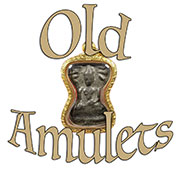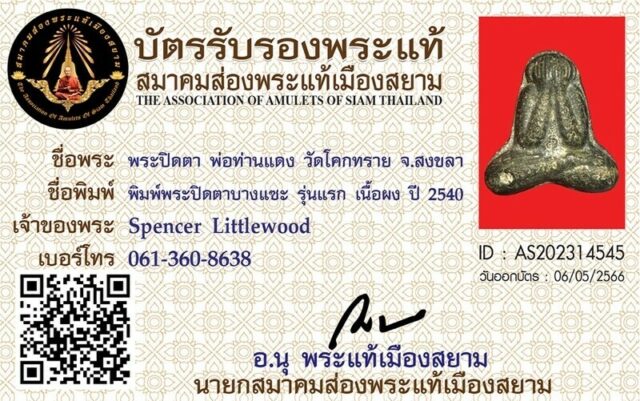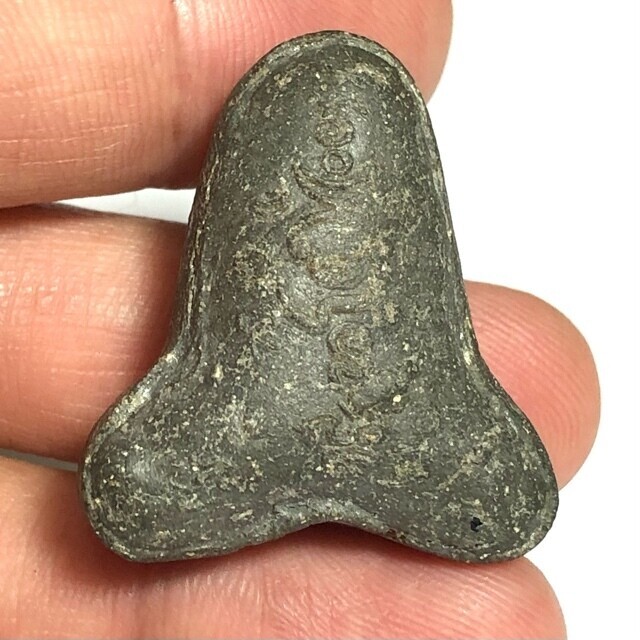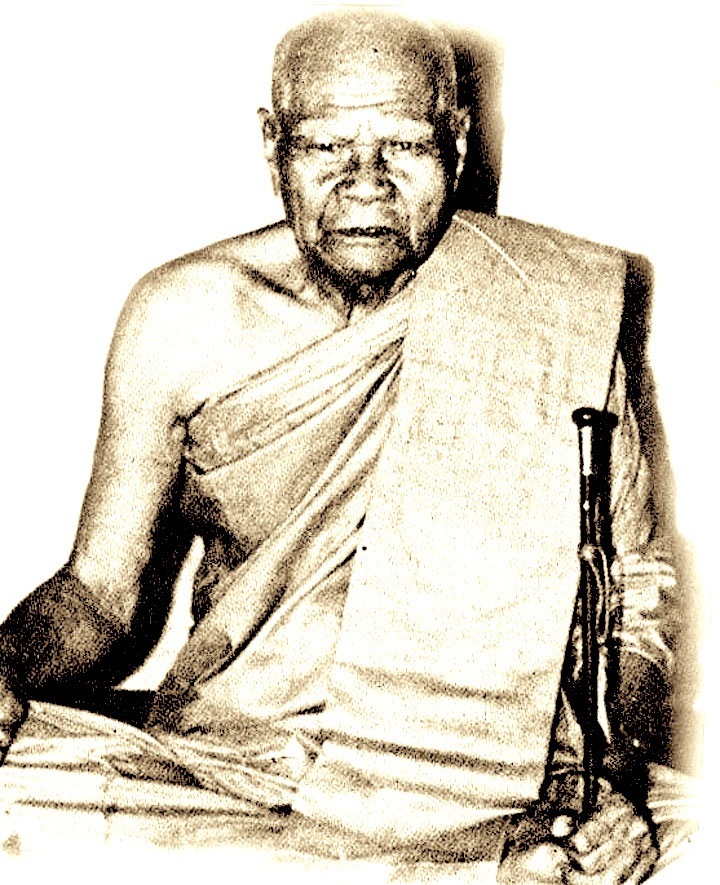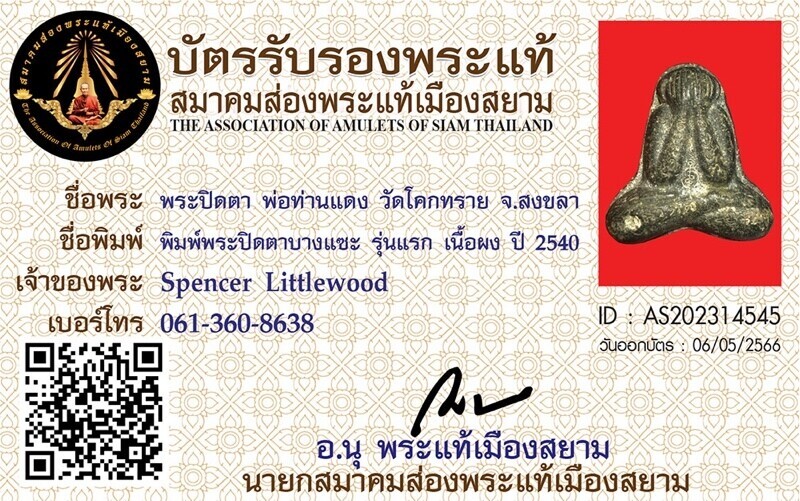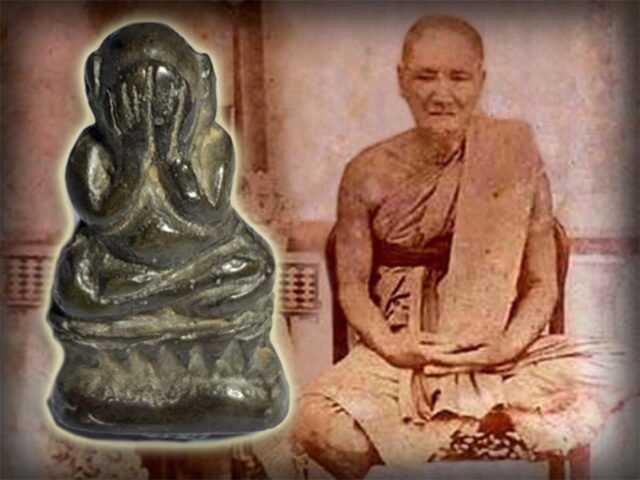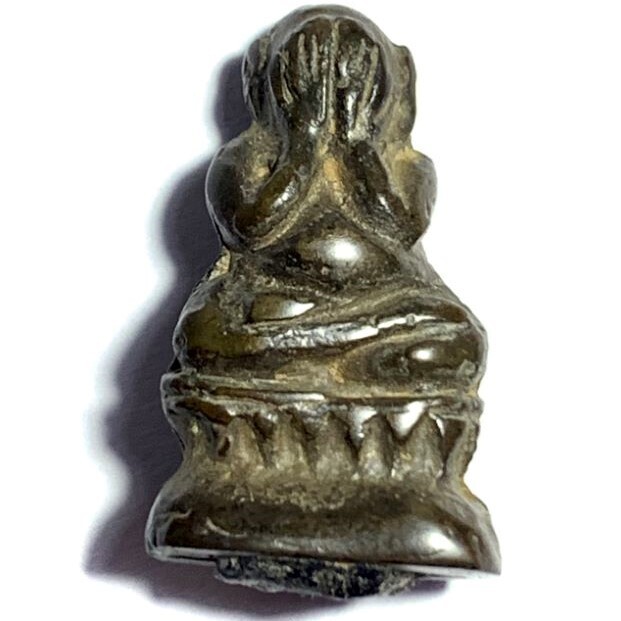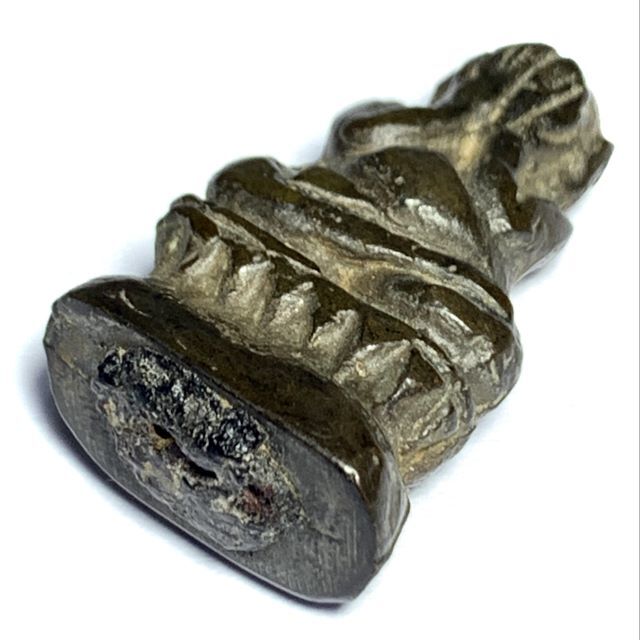Pra Pid Ta Pim Wat Bang Sae
Introducing a unique first-edition certificated amulet crafted by the esteemed Malaysian Monk, the Pra Pid Ta Por Tan Daeng, from Wat Koke Sai in Songkhla. This amulet represents the 1st edition ‘Pim Wat Bang Sae’ model, which pays homage to the style of the Pra Pid Ta amulets from the renowned Malaysian Monk, Luang Por Tan Kron of Wat Bang Sae. This amulet was released in the year 2540 BE and is meticulously crafted from Bailan Parchment powders. It is imbued with powerful Khom Aglkhara spells in ancient Khmer Sanskrit, traditionally used to empower this specific Wicha, as employed by Luang Por Kron for his Pra Pid Ta amulets.
Temple: Wat Koke Sai. Year of Issue: 2540 BE. Maker of Amulet: Por Tan Daeng. Recommended Uses: Maha Lap, Metta Maha Niyom, Klaew Klaad, Kong Grapan Chadtri, Maha Pokasap, Serm Duang. Number of Amulets Made: Unknown.Size of Amulet: 3.2 x 2.9 Cm. Material: Nea Pong Bailan Sacred Grimoire Soot and Kakyayaks earths. Additional Info: A rare amulet for followers of Por Tan Daeng the Luang Por Kron Lineage, Especially Popular with Malaysian Devotees.
Pra Kroo Aphai Sopon (Por Tan Daeng), formerly the Abbot of Chana District in Songkhla Province, hails from Kelantan, Malaysia. He is a direct disciple of Luang Por Kron from Bang Sae Temple, Malaysia. Por Tan Daeng has gained renown for creating highly revered amulets over the years, all of which are considered rare due to his status as the first apprentice (Looksit Aek) of the esteemed Luang Por Kron. He possesses a profound mastery of the magical Wicha associated with the Phra Pid Ta amulets of Wat Bang Sae in Malaysia.
The Pra Pidta Bang Sae comes in various types, made from sacred Muan Sarn powders and various models (Pim). These amulets are renowned for their potent magical properties and serve as excellent alternatives to the now exceedingly rare Pra Pid Ta amulets created by Luang Por Kron. They are not only powerful but also considered exquisite pieces of miniature sacred art. Collectors and aficionados hold the Pra Pid Ta Pim Wat Bang Sae in high regard, thanks to the powerful consecration ceremony conducted at Khok Sai Temple. The ceremony witnessed the participation of numerous revered monks, including Por Tan Daeng, Ajarn Sri Ngern (abbot of Wat Don Sala), Por Tan Khun Thong, Luang Por Sukh of Wat Duyong, Por Tan Chin of Wat Mueang Yala, Luang Por Hwaan, and many other esteemed monks from the Southern Provinces.
Luang Por Tan Daeng has since passed away, leaving behind a legacy of reverence. He was known for his straightforward nature and unwavering compassion. Whether conducting ordinations or rituals, he maintained strict adherence to the sanctity of Buddhist clergy. Por Tan Daeng also held the position of preceptor (Upachaya Ordaining Officer), a special designation granted to monks allowed to ordain others at their discretion.
Por Tan Daeng was renowned for his diligence and rigorous assessment of individuals seeking ordination as monks. He scrutinized their intentions, safeguarding the purity of Buddhism (Buddha-Sasana) by preventing those with ulterior motives from ordaining. Only those with sincere intentions were permitted to undergo the ordination ceremony, which required them to practice as lay practitioners in white clothing for an extended period to prove their commitment. Por Tan Daeng is revered as the Lineage Continuance Master of Luang Por Kron from Wat Bang Sae, ensuring the preservation and propagation of the Wicha Pra Pid Ta of Wat Bang Sae, initially established by Luang Por Kron.
About Luang Por Kron;
Luang Por Kron was referred to as ‘Tok Raja’ by Malays, a title signifying equality with the Sangha Raja. This name stemmed from a legend where a powerful Sultan of Kelantan had a daughter afflicted by a malevolent black magic spell. Despite seeking help from doctors and psychologists, her condition remained unchanged. Even the Muslim witch doctors failed to break the curse with their magic.
However, Luang Por Kron possessed the ability to heal her and restore her sanity. This miraculous act earned him the honorary title of Tok Raja from the Sultan, signifying his equal status with the Sangha Raja. Luang Por Kron’s preferred amulets include Pra Pid Ta Nuea Pong Kluk Rak and the Rian Roop Dork Jik coin amulet.
Pra Pid Ta amulets, as well as Pra Pid Ta in the form of Pha Yant and Bucha statues, have been crafted as objects of reverence and protection in Thailand for centuries. Artisans of that era created various styles and interpretations, drawing inspiration from different periods of Buddhist art and sculpture. Various deities were incorporated into the Pra Pid Ta posture, symbolizing the act of ‘covering the eyes.’ These amulets could close 7 or 9 orifices, with the former referred to as ‘Pra Pid Sadtatawarn’ and the latter as ‘Pra Pid Navatawarn.’
The Pra Pid Ta is renowned for its ‘Maha Ud’ (invincibility) and ‘Kong Grapan’ (gunstopping) properties. It is also crafted as a wealth-bringing amulet, referred to as ‘Pra Pid Ta Maha Lap.’ To enhance its resonance for wealth attraction and auspicious blessings, ancient artisans sometimes incorporated the image of the Sangkajjaiyana Buddha of riches and happiness into the Pid Ta posture.
